Bikes, skateboards and scooters
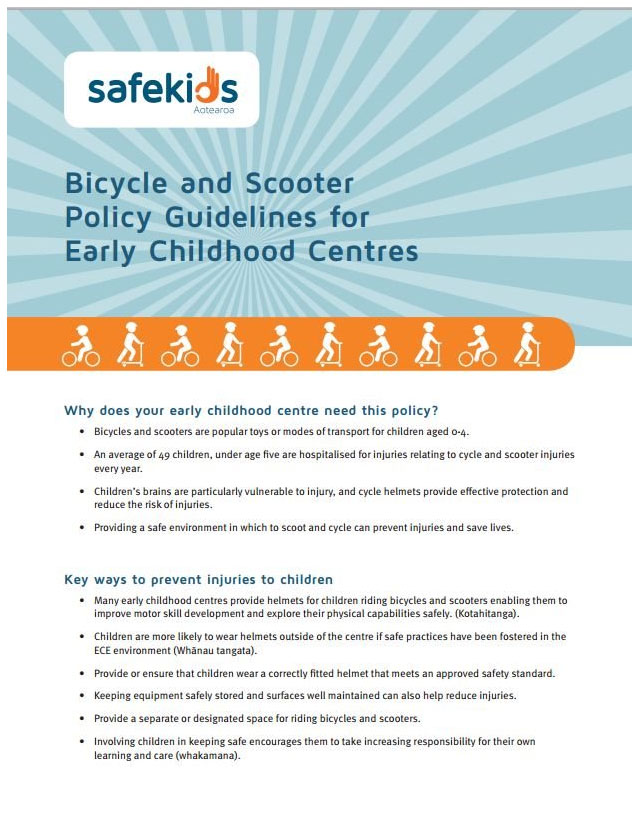
Bicycle and scooter policy guidelines for early childhood centres
[Pamphlet, 2014]
Two page policy document for early childhood centres on preventing injuries to children from the use of bicycles and scooters.
Download ECE bike and scootering policy >>
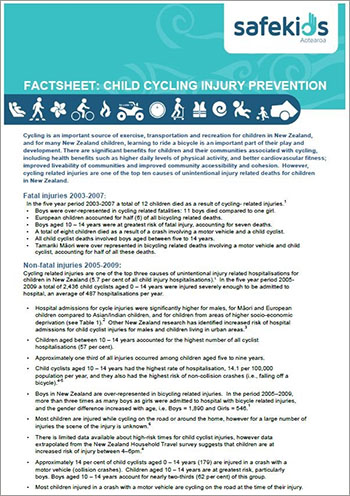
Child cycling injury prevention
[Factsheet, 2012]
This is a resource for practitioners and those running injury prevention programmes.
This new child cyclist injury prevention factsheet includes sections on: 'Fatal Injuries 2003-2007'; 'Non-fatal Injuries 2005-2009' and 'Interventions to reduce injuries to child cyclists':
1. Bicycle helmets 2. Bicycle skills training 3. Enhancing the safer use of bicycles as part of children’s active travel 4. Increasing the visibility of child cyclists 5. Engineering interventions and the impact of the built environment on encouraging safer cycling. Includes references.
Download Safekids Factsheet Child Cyclist Injuries>>

Child cycling injury prevention
[Position paper, 2012]
This A4 size 25 page position paper for injury prevention practitioners and policymakers looks at evidence from New Zealand and international research. Bicycles are an important source of exercise, transportation and recreation for children in New Zealand, and for many children, learning to ride a bicycle is an important part of their play and development.
There are significant benefits for children and their communities associated with cycling, including health benefits such as higher daily levels of physical activity, and better cardiovascular fitness; improved liveability of communities and improved community accessibility and cohesion. However, cycling related injuries are one of the top ten causes of unintentional injury related deaths for children in New Zealand.
This position paper includes information on the following interventions: 1. Bicycle helmets 2. Bicycle skills training 3. Enhancing the safer use of bicycles as part of children’s active travel 4. Increasing the visibility.
Download Child Cycling Injury Prevention PDF>>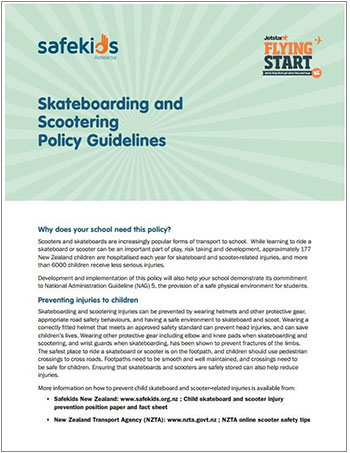
Schools Skateboarding and Scootering Policy Guidelines
[Pamphlet, 2013]
Scooters and skateboards are increasingly popular forms of transport to school. The purpose of this A4 pamphlet is to assist schools to reduce the risk of injuries from skateboarding and scootering to children, improve road safety and create a safer physical environment. The target audience is school boards of trustees.
The Safe2Scoot school policy document helps the school Board of Trustees create a safer scooter culture at your school. The aim of these policy guidelines is to provide assistance to schools about how they can reduce the risk of injuries to children, improve road safety and demonstrate their commitment to providing safe physical environments.
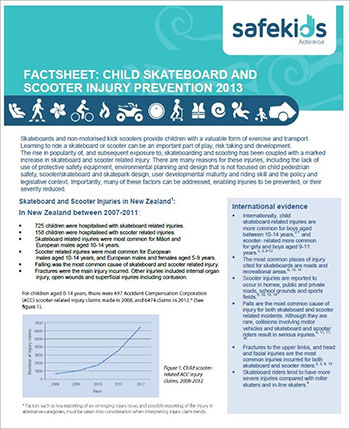
Child skateboard and scooter injury prevention
[Factsheet, 2013]
This is a resource for practitioners and those running injury prevention programmes. Includes sections on: Skateboard and scooter injuries in New Zealand, International evidence, Interventions to reduce injuries to child skateboarder and scooter riders - Helmets, Protective equipment, Skate park design, Safe child pedestrian space. Also includes the 'Safety Key Points': - Always wear a correctly fitting helmet that meets an approved safety standard - Always wear elbow and knee pads - Always wear wrist guards when skateboarding - Actively supervise children riding skateboards and scooters - Skateboard and scoot carefully in pedestrian areas, and use pedestrian crossings.
Download Factsheet Child skateboard and scooter Injury Prevention>>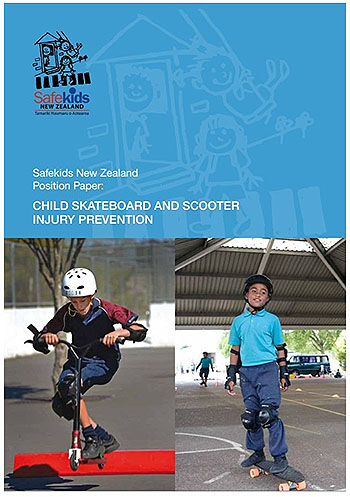
Child skateboard and scooter injury prevention
[Position paper, 2013]
This A4 size 25 page position paper for injury prevention practitioners and policymakers looks at evidence from New Zealand and international research.
It includes sections on: Skateboard and scooter-related child injury, New Zealand legislation and requirements, Intervention to reduce injuries to child skateboarders and scooter riders - Protective equipment and supervision, Engineering solutions to enable safe pedestrian space, Other interventions, Safekids NZ recommendations. Includes appendices and detailed references.
This is a resource for practitioners and those running injury prevention programmes.
Download Safekids Child Skateboard and 'Scooter Injury Prevention Position Paper>>

How to be safe 2 scoot
[Poster, 2011]
This A3-sized poster includes the text: "Wearing a helmet on your scooter can stop your brain getting badly hurt if you fall off.
So follow the simple steps below to make sure you are wearing your helmet properly.
It promotes the 2-4-1 rule: - 2 The helmet should be no more than two fingers above your eyebrow. - 4 Adjust the straps just under your ear.
It should form two 'V's - 1 No more than one finger should fit under the chin strap.
